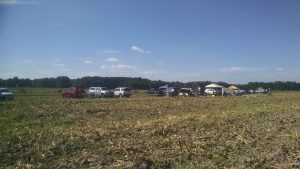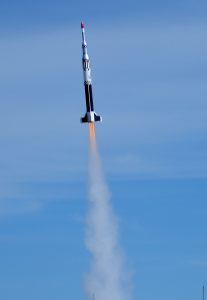We got the 2017-2018 High-Power Season off to a great start in Bayboro this weekend, with a little bit of everything.? We had old friends show up, certification flights, lots of people pushing the envelope, and lots of successes.? The weather was great!!? Mild temperatures, clear skies, and moderate winds.? The only problems were the wind direction (towards the closest tree line) and the ground surface (freshly disced corn stubble, which tried to trip you up and turn your ankles at every step.).?? It was not just the old guys like myself who were having trouble with the terrain, I heard a number of the younger flyers complain about the footing.?? We need to keep in mind that September is one of those ?maybe/maybe not? months for our host.?? The corn has been mostly harvested, but the soybeans are still on the stalk.? A lot of foot traffic through the beans will just shake the pods off the stalk, resulting in loss of revenue.?? I know that there are many of you who have attempted to recover rockets in the middle of soybean fields, and you know that it is not any fun.
 Photo by Dave Morey
Photo by Dave Morey
Therefore, in September we set up where Clifton wants us to set up and modify our expectations accordingly.? We will probably be back at our usual launch site next month.? Even within these restrictions, a lot of people showed up and had a lot of fun.? I?ll stick in the World Famous Motor Use Summary Table here:
|
Sat |
Sun |
Total |
| A |
1 |
|
1 |
| B |
|
|
|
| C |
3 |
|
3 |
| D |
2 |
|
2 |
| E |
3 |
1 |
4 |
| F |
4 |
|
4 |
| G |
4 |
3 |
7 |
| H |
7 |
5 |
12 |
| I |
9 |
1 |
10 |
| J |
1 |
2 |
3 |
| K |
1 |
|
1 |
| Total |
34 |
12 |
46 |
I shall browse through the flight cards and mention flyers and flights that caught my interest.? The order is generally ?small motor? to ?large motor? but not exactly.? Ed Withers brought a Semroc kit called the Batroc that I had not seen before.? It flew quite well on an A8.? Allen Harrell (ably assisted by his granddad Tommy and Aunt Natalie) had a few flights in the low-power range, also, with two C6-powered flights and Wigglewump on an F24.? Special thanks to Natalie for the cookies, this time both chocolate chip and oatmeal/date varieties.
The first flight of the 2017/2018 season was made by Dan Fritsch, who flew his Madcow Mini Cowabunga on a D12.?? This is an interesting coincidence, because in September of 2007, exactly 10 years ago, I made the first flight ever at the Bayboro field with my own Jaguar loaded with an Estes D12.? Somebody suggested that we should make this an annual ritual, for good luck.?? The first flight of each season at Bayboro should be made by somebody flying an Estes D12.?? Works for me.
We all need to say a big Thank You to Mike Collier, who took most of the launch pads back to his place of business over the summer and completely re-built most of our mid-power launch pads.? The old yellow tripod, which had corroded away to a loose set of steel tubes, was totally reconstructed, and both of the quad-pods were rebuilt in a more stable arrangement.?? Both of the quad-pods can handle 10-10 and 15-15 rails, as well as a variety of rods.?? Mike also welded the loose nut back on one of the legs of Kelly Mercer?s old Unistrut rail pad.?? If that weren?t enough, he also had 2 big decals of the club logo printed up and applied them to the club trailer.?? Have a look during the next launch.?? We all owe Mike a big debt of gratitude.?? Check out the pads and thank Mike yourself at a future launch.?? We also need to thank David Cox, who went through the beat-up high-power launch controller and the trolley on wheels that contains the launch relay circuits.?? David fixed all the broken buttons and switches, got the continuity check functions working again, and gave us 5 working channels to play with while Kurt Hesse gets the new system finished.
One of my greatest pleasures is seeing old friends from the Whitakers days come back and join us at Bayboro.? This month Thomas Cox returned to the hobby and had a successful L1 TRA re-certification flight using his Blue Phenix and flying on an Aerotech I357T.?? Flight and recovery were perfect, so, welcome back to High Power!? Thomas also had some problems with old Aerotech motors left over from the Whitakers days, some of which were very hard to light.? One particular motor never ignited the propellant, but the delay grain lit up and burned for more than 25 seconds, producing smoke out the back until the ejection charge finally fired, popping off the nose cone and parachute.
Mike Nay has been working on his cluster ignition project for a while, and on Saturday he finally got it to work.? His Triple Trouble #2 was loaded with a central E16 and two D12?s in detachable side pods, each of which were designed to come down under its own parachute.?? On Saturday, he finally got everything to work on time and in the way they were designed.?? The total installed impulse for this flight was in the F motor range, so? this flight is listed under the F motors in the motor use summary.

Photo By Jim Livingston
I haven?t awarded the ?best rocket name? award in a while, but this month it will have to go to Steve Polk?s Disturbing News, which resembled a CBU or some other piece of military airplane-dropped weaponry.?? This was flown on an Aerotech H180W for a successful flight.? Dave Morey had a great flight with his Loc IV, which used a central I245G and air-started 4 D5?s, mainly for a lot of smoke.? Everything worked exactly like Dave programmed it, and recovery was perfect.
Saturday?s biggest motor was flown by C. J. Lucas in his Eagle Claw 4.? The motor was a homemade 54mm J595, which he made himself, not just the propellant but he machined the casing and nozzle, also.?? The flight was perfect and recovery was exactly right.
Sunday was a little more windy, and the direction was still less than desirable.?? Robbie Kirk came back to fly some more rockets in the F through H range.? Henry and Sam Hartman joined us on Sunday and took advantage of the great weather to fly several rockets in the G to H range, to great success as I recall.??? Sam Delong made the trip from Wilmington to do some serious flying on Sunday.? I have cards in the box that record flights with a G64W, H54W, H180W, J244 and J290 motors.? Apparently Sam likes the white-smoke formulas!
The big deal on Sunday was the culmination of a lengthy, quixotic attempt by Joe Hill to airstart 2 outboard motors using the old-school method of igniting therma-lite segments with flash bulbs, while one end of the therma-lite is stuck up in the outboard motors.?? He tried and failed on Saturday, with a central Loki I210 and two outboard AT G53FJ motors.?? The I motor lit just fine and the flight was safe and recovered intact, but the outboard G?s did not light.?? On Sunday Joe tried again with a central Loki I377CT and the same two outboard G53?s.?? This time everything worked exactly as planned, and the flight was spectacular.? A perfect initial I377 burn, followed by a smoky G-motor boost.?? Like all successful airstarts, it was a treat to watch.
I have started keeping score on the Jolly Logic Chute Release product.? This month we had 10 Jolly Logic flights, 8 of which worked as planned, and 2 which did not open on schedule.? We shall pursue this matter and try to find out why the successful flights worked and the unsuccessful ones did not.? Every rocket flight is an experiment, and we can learn something if we gather the data and catalogue it.
Alan Whitmore
Prefect, Tripoli East NC



